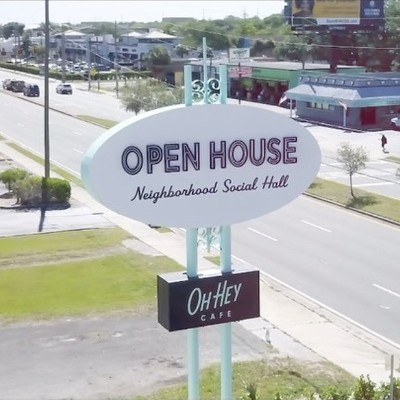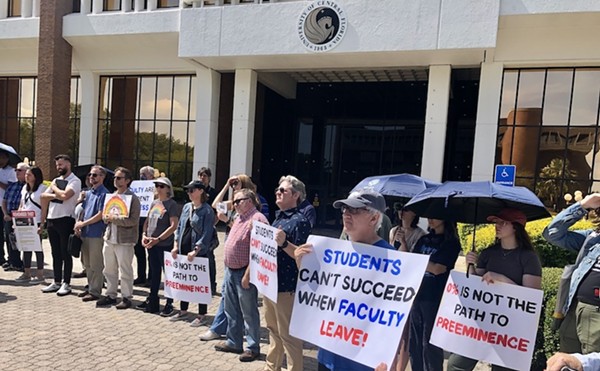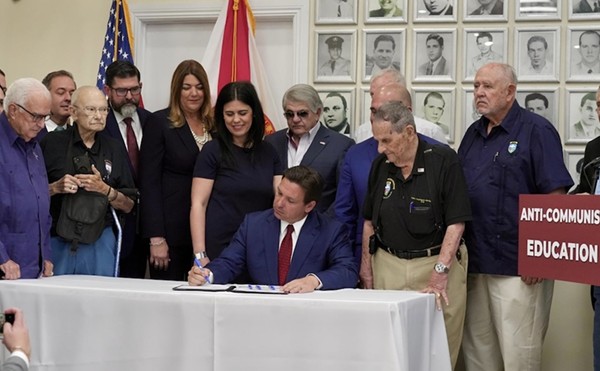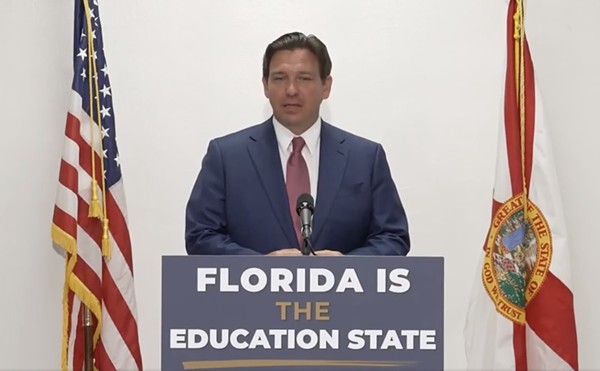If WFTV Channel 9 is to be believed, Sept. 4 was a very dangerous day to be a Central Floridian.
A couple was charged in a stabbing incident in a Sanford counseling center. Another man was arrested for a shooting that occurred in broad daylight in the middle of a busy intersection. A Volusia County deputy may have driven drunk and crashed, and his cop buddies may have covered it up. There was a pipe-bomb scare in Indialantic. Deltona passed a strict teenage curfew to alleviate a dangerous gang problem. A College Park neighborhood demanded “neighborhood watch” signs from Orlando, in an effort to get criminals to stop breaking into their houses. And that was just the first 16 minutes of the 6 p.m. broadcast. Give or take a few minutes, that’s usually how it goes for local TV news.
Factoring out commercials, Channel 9 devoted two-thirds of that Sept. 4 news programming – the part before weather and sports, which dominate the latter third (and sometimes more) of each broadcast – to stories about crime. In this case, the station gave nine minutes and 15 seconds to crime and mayhem and only five minutes to other stories, such as the fact that Orlando International Airport is seeing increasing delays, which got about 30 seconds.
That same day’s 11 p.m. broadcast was more of the same. An Orange County couple was robbed and pistol-whipped. A Daytona Beach man tried to kidnap a 12-year-old girl. Orange County deputies arrested a man who shot a cabbie in the face. A family was outraged that the man who killed their son in a hit-and-run only got a year in jail. Burglars knocked off liquor stores in Altamonte Springs. A suspect was wanted for holding up a string of Marion County convenience stores.
It’s enough to scare you into never leaving your house again. Or perhaps you need to get a concealed weapons permit. Maybe it’s time to give up some of your civil liberties so you can be a little safer. At the very least it’s time to, once again, demand that elected officials get more cops on our dangerous streets.
Or could it be time to stop watching so much local TV news, which is addicted to reporting about violence and mayhem because it’s a cheap, easy way to fill a newscast? Here’s a headline you probably won’t see on local TV news: Some crimes are down in Orlando, and our streets are relatively safe.
As compared to the first six months of 2006, the first half of 2007 saw a more than 20 percent drop in murder and rape rates, according to FBI statistics. Robberies are up about 10 percent. Aggravated assaults have stayed about the same. During the last decade, Florida Department of Law Enforcement stats suggest a steep decline in the state’s crime rates. In 1997, for example, the FDLE registered nearly 1.1 million total crimes. By 2006, that was down to about 850,000, even as the state grew in population from 14.7 million to more than 18 million. In terms of per capita crime, that’s a 36 percent drop.
Which is not to say that crime isn’t a problem here. It is. According to 2006 FDLE data, Orange County has the highest per capita crime rate in the state: about 6,347 incidents per 100,000 people. Other area counties are relatively safer: Seminole County’s rate is 3,228 per 100,000 people; Lake County’s is 3,337; Volusia County’s is 4,338.
But that means that if you are an Orange County resident, your chances of being a victim of crime in 2006 were about 6.3 percent. (That assumes that no individual was the victim of more than one crime, which would make that percentage lower.) Those numbers include both violent crime, such as murder and sex offenses, and property crimes, such as larceny and grand theft. Your chances of being a victim of violent crime were much lower. According to the FDLE, in 2006 Florida had 129,501 incidences of violent crime, or a rate of about 706 violent crimes per 100,000 people. That’s a .5 percent chance of being a victim of violent crime, statewide.
According to FBI data, your risk of victimhood is about the same inside Orlando city limits. In 2005, Orlando, with a population of 210,290, reported 1,805 violent crimes. That means that in 2005, your statistical chance of being a victim of a violent crime in Orlando was less than 1 percent.
To put it in perspective, your chances of dying in a car accident are about three times that of being murdered. In Florida in 2006, 3,374 people died in traffic accidents, according to data from the National Highway Traffic Safety Association. That same year, Florida saw 1,129 murders, according to the FDLE.
Nonetheless, crime is a part of life, and it should be part of the daily news. In fact, that’s exactly what station managers say you want. “Crime is the No. 1 issue with our viewers,” says Local 6 station manager Henry Maldonado.
But the issue is one of perspective. If Channel 9 had spent just 10 percent of their Sept. 4 6 p.m. broadcast on crime – which one could argue would be in line with its relevance to everyday life in Orange County – you would have seen just over a minute of it that day, instead of almost nine and a half minutes.
Of course, Channel 9 isn’t the only local station addicted to crime. For about three weeks, with the help of a DVR, I watched dozens of local news broadcasts from the four networks, chronicling the amount of time they devoted to each story. The survey wasn’t exactly up to social-science methodology, but it was close enough to come to the conclusion that local news is trying to scare you to keep you watching.
The old saw “If it bleeds, it leads” is alive and well in Orlando.
Hide the kids
“The sex offender who lives right there is being watched,” WESH-TV Channel 2’s Aug. 29 11 p.m. broadcast announced.
The station dispatched a reporter to Palm Bay to stand on the street in front of an unnamed person’s house. The story – to which Channel 2 gave a minute and a half of airtime – was about a Palm Bay cop whose job is to knock on sex offenders’ doors and make sure they’re home.
It was the second story on the newscast, which means someone at Channel 2 ranked it only behind a story about a Wal-Mart shoplifting incident gone violent as the day’s most important news item.
You might think some other stories would be more important to your life. For example, Channel 2 reported on a new airport screening policy that makes passengers with head coverings subject to secondary inspections – tantamount to discrimination – but the station thought that worth only 10 seconds of airtime, sandwiched between a weather preview (30 seconds) and a story about inspections of 737 airplanes (20 seconds).
But anything involving a sex offender is broadcast gold. On Aug. 27, WKMG-TV Channel 6 led its 6 p.m. broadcast with a story about an alleged sex offender who bonded out of jail and moved back to his house, next door to the alleged 12-year-old victim. Two minutes into the story, the Local 6 reporter mentioned this important fact: “He’s not been convicted of anything.” Anchor Bob Frier reminded us to be scared anyway: “It’s an important situation for parents. There are plenty of sex offenders living in our neighborhoods.”
(Reality check: There are indeed a lot of registered sex offenders living among us; some 33,000, in fact. But there are about 18 million people in Florida.)
Local 6 followed that story with a report on their Aug. 27 11 p.m. broadcast about a 12-year-old girl who said a man tried to lure her into his convertible with $100. She declined. Nonetheless, the story consumed the first three minutes of the show.
On Aug. 31 at 6 p.m., Local 6 reported – as did the other three stations – on the arrest of a Disney worker on child pornography charges. But Local 6 spent two minutes documenting a litany of accused sex offenders employed at local theme parks without mentioning that since Disney is the area’s biggest employer, statistically speaking it’s bound to have some bad apples.
On its Sept. 4 11 p.m. broadcast, Channel 9 spent 90 seconds on the story of a Daytona Beach girl who called her father, a cop, after a Hispanic man tried to get her into his car. She got away unharmed. The next day the station spent 45 seconds on rape allegations a 12-year-old girl made against a hotel maintenance manager who was later found not guilty.
On Aug. 30, Channel 2 spent three minutes detailing the case of a man who allegedly molested some neighborhood boys, and was then shot by one of his victims.
Nothing is mundane
“Local officers are finding themselves under attack!”
So declared the introduction to Local 6’s Aug. 29 11 p.m. broadcast, in which a reporter interviewed a police officer who said he was once shot at and another time spit on. The reporter said there had been a 22 percent increase in batteries against Orlando police officers from 2006 to 2007 and an 8 percent increase in the same time period against Orange County sheriff’s deputies. Police blame parents, schools, video games and the juvenile justice system.
Anchor Frier asked if this uptick was linked to OPD’s crackdown in high-crime neighborhoods, a logical conclusion. “Absolutely not,” the reporter replied, going on to say that cops link the attacks to a rise in violent crime, which according to OPD’s own stats isn’t rising compared to last year.
On Aug. 28, Local 6 ran a story about a low-key police chase that began and ended in the suspect’s front yard. Police told the station that the chase was never dangerous. Anchor Marla Weech had a different opinion: “We also know these chases can be dangerous.”
These are two examples of broadcast journalism rule No. 1: Nothing is mundane, even the mundane. (Sometimes, the requisite foreboding tone produces comical results. On Aug. 28, Channel 2 reported that astronaut Lisa Nowak was considering a temporary insanity defense for her upcoming trial. Reporter Dan Billow offered this nugget of wisdom: “It’s dangerous to have astronauts in a position to be insane, even temporarily.”)
Just as important as hype is projecting the notion that the station is doing something about the woes plaguing our city.
On Aug. 30, Local 6’s Frier claimed credit for an arrest: The family of a woman who died at a nursing home “may be getting justice, thanks to Local 6.” How so? Well, the authorities had issued an arrest warrant for a nursing home nurse manager who allegedly didn’t act when an 89-year-old patient developed an impacted colon. The woman died. Local 6 found the “fugitive” hiding at her home, and told her she had an arrest warrant out. (Teaser for the segment: “Local 6 leads police to a wanted criminal!”)
Get the shot
Broadcast journalism axiom No. 2: Video trumps all.
On Sept. 12, Fox 35’s 6 p.m. newscast put video of a teenager being subdued by cops among its top stories. According to the report, the 18-year-old didn’t want to be caught drinking underage, so he struggled with police and punched a police dog.
On Aug. 28, Local 6 had a police car–chase video as the day’s second item for its 11 p.m. broadcast. On Sept. 4, Channel 9 devoted almost three minutes of its 11 p.m. newscast to video surveillance tapes of liquor store robberies in Altamonte Springs and tape of a man who allegedly knocked off 11 Marion County convenience stores. Channel 2 prominently featured video of a robbery at a Burlington Coat Factory Aug. 31.
On Aug. 31, two men robbed a house on Silver Star Road. Police tracked them to the intersection of Mercy Drive and Princeton Street. Local 6 dispatched Erik von Ancken to the scene, or at least as close as he could get, about a quarter-mile away. He didn’t get much up-to-date information, other than saying a cop with an assault rifle looked like he was “ready for a suspect on the loose.”
Later in that broadcast, Local 6 cut back to the scene, where the cops had in fact shot a suspect. “Whether he’s dead or alive, we don’t know,” von Ancken intoned. (He was dead.) Local 6 took the remarkable step of forgoing its sports segment to stay on the scene.
The real world
This isn’t to say local television stations don’t, from time to time, produce enterprising work. Over the years, a handful of TV news investigative scoops have stirred things up: Local 6’s investigation into a LYNX junket in Las Vegas, for example, or more recently the station’s revelations about political gadabout Doug Guetzloe’s dealings. In 2005, Channel 2 ran an excellent investigative series chronicling FEMA waste and mismanagement in the wake of the 2004 hurricanes. Local television contributed meaningful reporting to last year’s Orlando-Orange County Expressway Authority scandal as well.
Still, those stories are far outnumbered by the quick, easy and sensational, which more often than not means violence. The worst offender locally, Channel 9, is the ratings champ, at least as of July. That same month Channel 2, the most restrained of the bunch, placed a distant third at 6 p.m.
Such journalism has repercussions. An academic study titled “Prime Suspects: The Influence of Local Television News on the Viewing Public” that appeared in the July 2000 edition of the American Journal of Political Science suggests that such coverage reinforces negative racial stereotypes. Breathless reporting on sex offenders has led, at least in part, to municipalities’ draconian rules relegating sex offenders to the hinterlands.
The other effect is to create a perception of Orlando being more dangerous than it really is. As Orlando police chief Mike McCoy told Orlando Weekly last year, “We tell people that if you’re not dealing drugs, living with people dealing drugs, buying drugs, picking up prostitutes at 3 in the morning, or you’re not living in an unstable domestic relationship with a firearm in the house, your chances `of being a violent crime victim` are relatively slim.”
That’s from the guy whose job it is to know as much as possible about crime in this city.
The stations are cognizant of the criticism that they overstate crime. As Local 6’s Maldonado says, it’s a “double-edged sword.” His station can’t ignore crime, he says, but it’s easy to overdo it as well.
“It’s a danger if you’re misportraying it the other way,” he says. “That would be a disservice too.”
Maldonado discourages his producers from stringing together crime blocks, with a half-dozen crime stories stacked on top of each other. He acknowledges that crime is more likely to get cast prominently on the evening news if it is “dramatic,” but that’s the nature of the business.
Channel 9 managing editor Joel Davis says his station judges whether or not to put a crime story on air by whether or not there’s a community threat, and whether the story involves children. Davis says thinks viewers respond to stories that are “local, significant and original,” and says the station has dominated local rating for the last three decades because it produces a fast-paced, businesslike newscast heavy on enterprising reporting. “We pride ourselves on having the reporters who go out and are able to bring stories to the table instead of following local media,” he says. “They have the ability to be old-style shoe-leather reporters.”
Nonetheless, TV news’ reliance on quick and easy crime hits eats up time that could be spent on other stories. On Aug. 27, for example, Local 6 devoted almost three minutes of its 6 p.m. broadcast to sex offender–related stories, but didn’t mention that Alberto Gonzalez had resigned as attorney general of the United States.
For the most part, issues deemed unsexy are largely ignored: On Aug. 29, for instance, a key Republican on the House Education Appropriations Committee created a list of education programs that he wouldn’t allow to fall victim to budget cuts, including financial aid for college students and school-bus expenses. You might have read about it in the next day’s Orlando Sentinel, but you wouldn’t have heard a word about it on either Channels 2 or 6 that day.
On Sept. 10, House leaders sent a letter to Gov. Charlie Crist signaling that they wouldn’t back his plan to expand gambling to raise revenue. Fox 35 didn’t mention that, but did spend almost three minutes pleading the case of a chaplain in Leesburg who says he was fired for praying in Jesus’ name, and then promoting an upcoming protest march some churches were organizing for later that week.
It’s not just the stories the stations ignore that are problematic; it’s also the stories that never get reported. We’ll never know what a team of well-funded, enterprising journalists could have turned up, but didn’t. Broadcast journalism should be, and can be, more than a high-tech police blotter.
Unfortunately, it’s often not.
[email protected]


















